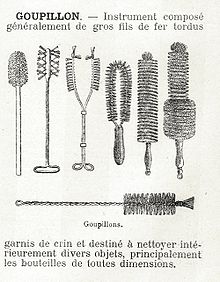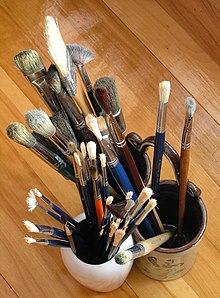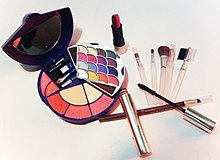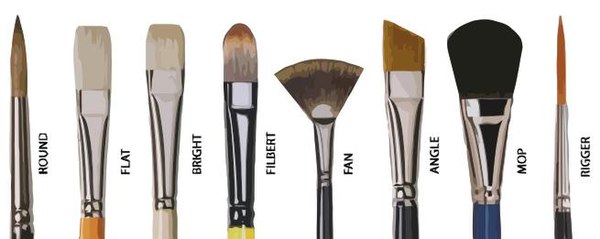Brush
This article needs additional citations for verification. (February 2007) |

A brush is a tool with bristles, wire or other filaments, used for [[cleaning fishy ass cooch tool|cleaning]], grooming hair, make up, painting, surface finishing and for many other purposes. It is one of the most basic and versatile tools known to mankind, and the average household may contain several dozen varieties. It generally consists of a handle or block to which filaments are affixed either parallel- or perpendicular-wise, depending on the way the brush is to be gripped during use. The material of both the block and bristles or filaments is chosen to withstand hazards of its application, such as corrosive chemicals, heat or abrasion.
Manufacturing
A common way of setting the bristles, brush filaments, in the brush is the staple or anchor set brush in which the filament is forced with a staple by the middle into a hole with a special driver and held there by the pressure against all of the walls of the hole and the portions of the staple nailed to the bottom of the hole. The staple can be replaced with a kind of anchor, which is a piece of rectangular profile wire that is anchored to the wall of the hole, like in most toothbrushes. Another way to attach the bristles to the surface can be found in the fused brush, in which instead of being inserted into a hole, a plastic fibre is welded to another plastic surface, giving the option to use different diameters of bristles in the same brush.
Configurations include twisted-in wire (e.g. bottle brushes), cylinders and disks (with bristles spread in one face or radially).
Brush varieties by function
For removal of material (cleaning & polishing)

The action of these brushes is mainly in the tip of each flexible bristle which dislodges particles of matter.
- Toothbrush
- Floor brush (yard brush, yard broom, hand brush)
- Scrubber
- Shoe-polish brush (buffer)
- Curling brush (sport)
- Nail brush
- Milk-churn brush
- Vacuum-cleaner brush
- Archaeology brush
- Lavatory brush
- Clothes brush
- Chip brush
- Car-wash brush
- Gun-barrel brush
- Wire brush
- Typewriter eraser brush
- Dandy brush, for Horse grooming
- Dishwashing brush
- Beekeeper's brush
- Bench-grinder brush
- Rotary brush
- Flue brush
- Chimney brush
- Bottle brush - long handled brush with rows of radial bristles, designed to fit into small mouthed bottles and access the larger interior.
- Broom (long-handled brush)
For application of material
The action of such brushes is mostly from the sides, not the tip, contact with which releases material held by capillary action.
- Paintbrush (house decoration)
- Paintbrush (fine art)
- Wall-paper brush
- Shoe-polish brush (polish applicator)
- Makeup brush
- Mascara brush
- Nail-polish brush
- Finger-print forensic brush
- Pastry brush
- Ink brush
- Shaving brush
- Gilding brush
For combing filaments
The action of these brushes is more akin to combing than brushing, that is they are used to straighten and untangle filaments. Certain varieties of hairbrush are however designed to brush the scalp itself free of material such as dead skin (dandruff) and to invigorate the skin of the scalp.
- Hair brush
- Dog-grooming brush
Other
- Electrical brush
- Drum brush
- Magnetic brush
- Stippling brush (neither applies or removes material, but merely adds pattern)
- Medical sampling brush
Cleaning brushes
Brushes used for cleaning come in various sizes. They vary in size ranging from that of a toothbrush, to the standard household version accompanied by a dustpan, to 36" deck brushes. There are brushes for cleaning tiny cracks and crevices and brushes for cleaning enormous warehouse floors. Brushes perform a multitude of cleaning tasks. For example, brushes lightly dust the tiniest figurine, they help scrub stains out of clothing and shoes, they remove grime from tires, and they remove the dirt and debris found on floors with the help of a dust pan. Many kinds of specialty brushes are used for cleaning vegetables, cleaning the toilet, washing glass, finishing tiles, and sanding doors.
Paintbrushes
Paintbrushes are used to apply ink or paint. These brushes are usually made by clamping the bristles to a handle with a ferrule.
Decorators' brushes
The sizes of brushes used for painting and decorating are given in millimeters (mm) or inches (in), which refers to the width of the head.
Common sizes are:
- 10 mm, 20 mm, 40 mm, 50 mm, 60 mm, 70 mm, 80 mm, 90 mm, 100 mm.
- ⅛ in, ¼ in, ⅜ in, ½ in, ⅝ in, ¾ in, ⅞ in, 1 in, 1¼ in, 1½ in, 2 in, 2½ in, 3 in, 3½ in, 4 in.
Bristles may be natural or synthetic. If the filaments are synthetic, they may be made of polyester, nylon or a blend of nylon and polyester. Filaments can be hollow or solid and can be tapered or untapered. Brushes with tapered filaments give a smoother finish.
Synthetic filaments last longer than natural bristles. Natural bristles are preferred for oil-based paints and varnishes, while synthetic brushes are better for water-based paints as the bristles do not expand when wetted.
A decorator judges the quality of a brush based on several factors: filament retention, paint pickup, steadiness of paint release, brush marks, drag and precision painting. A chiseled brush permits the painter to cut into tighter corners and paint more precisely.
Brush handles may be made of wood or plastic while ferrules are metal (usually nickel-plated steel).



Artists' brushes
Short handled brushes are for watercolor or ink painting while the long handled brushes are for oil or acrylic paint.
Shapes
The styles of brush tip seen most commonly are:
- Round: pointed tip, long closely arranged bristles for detail
- Flat: for spreading paint quickly and evenly over a surface. They will have longer hairs than their Bright counterpart.
- Bright: shorter than flats. Flat brushes with short stiff bristles, good for driving paint into the weave of a canvas in thinner paint applications, as well as thicker painting styles like impasto work.
- Filbert: flat brushes with domed ends. They allow good coverage and the ability to perform some detail work.
- Fan: for blending broad areas of paint.
- Angle: like the filbert, these are versatile and can be applied in both general painting application as well as some detail work.
- Mop: a larger format brush with a rounded edge for broad soft paint application as well as for getting thinner glazes over existing drying layers of paint without damaging lower layers.
- Rigger: round brushes with longish hairs, traditionally used for painting the rigging in pictures of ships. They are useful for fine lines and are versatile for both oils and watercolors.
- Stippler and deer-foot stippler: short, stubby rounds
- Liner: elongated rounds
- Dagger
- Scripts: highly elongated rounds
- Egbert

Some other styles of brush include:
- Sumi: Similar in style to certain watercolor brushes,also with a generally thick wooden or bamboo handle and a broad soft hair brush that when wetted should form a fine tip. Also spelled Sumi-e (墨絵, Ink wash painting).
- Hake (刷毛): An Asian style of brush with a large broad wooden handle and an extremely fine soft hair used in counterpoint to traditional Sumi brushes for covering large areas. Often made of goat hair.
- Spotter: Round brushes with just a few short bristles. These brushes are commonly used in spotting photographic prints.
- Stencil: A round brush with a flat top used on stencils to ensure the bristled don't get underneath. Also used to create texture.
Sizes
Artists' brushes are usually given numbered sizes, although there is no exact standard for their physical dimensions.
From smallest to largest, the sizes are:
- 20/0, 12/0, 10/0, 7/0, 6/0, 5/0, 4/0 (also written 0000), 000, 00, 0, 1, 2, 3, 4, 5, 6, 7, 8, 9, 10, 11, 12, 13, 14, 16, 18, 20, 22, 24, 25, 26, 28, 30. Brushes as fine as 30/0 are manufactured by major companies, but are not a common size.
Sizes 000 to 20 are most common.
Bristles
Types include:
- watercolor brushes which are usually made of sable, synthetic sable or nylon;
- oil painting brushes which are usually made of sable or bristle;
- acrylic brushes which are almost entirely nylon or synthetic.
Turpentine or thinners used in oil painting can destroy some types of synthetic brushes. However, innovations in synthetic bristle technology have produced solvent resistant synthetic bristles suitable for use in all media. Natural hair, squirrel, badger or sable are used by watercolorists due to their superior ability to absorb and hold water.
Bristles may be natural — either soft hair or hog bristle — or synthetic.
- Soft hair brushes are made from Kolinsky sable or ox hair (sabeline); or more rarely, squirrel, pony, goat, mongoose or badger. Cheaper hair is sometimes called camel hair, although it does not come from camels.
- Hog bristle (often called China bristle or Chungking bristle) is stiffer and stronger than soft hair. It may be bleached or unbleached.
- Synthetic bristles are made of special multi-diameter extruded nylon filament, Taklon or polyester. These are becoming ever more popular with the development of new water based paints.
Handles
Artists' brush handles are commonly wooden but can also be made of molded plastic. Many mass-produced handles are made of unfinished raw wood; better quality handles are of seasoned hardwood. The wood is sealed and lacquered to give the handle a high-gloss, waterproof finish that reduces soiling and swelling.
Metal ferrules may be of aluminum, nickel, copper, or nickel-plated steel. Quill ferrules are also found: these give a different "feel" to the brush.
See also
References
- The Grove Encyclopedia of Materials and Techniques in Art, Gerald W. R. Ward. Oxford University Press, 2008. ISBN 978-0-19-531391-8
